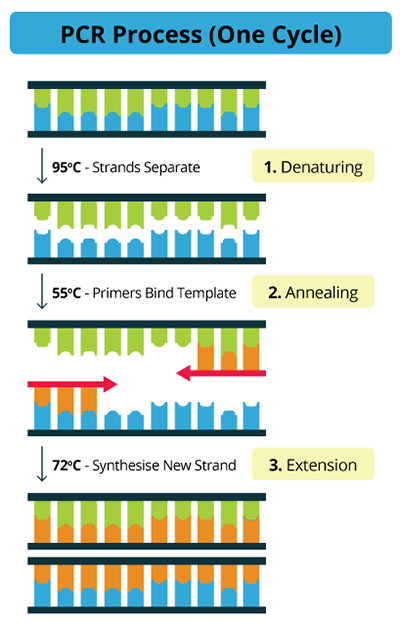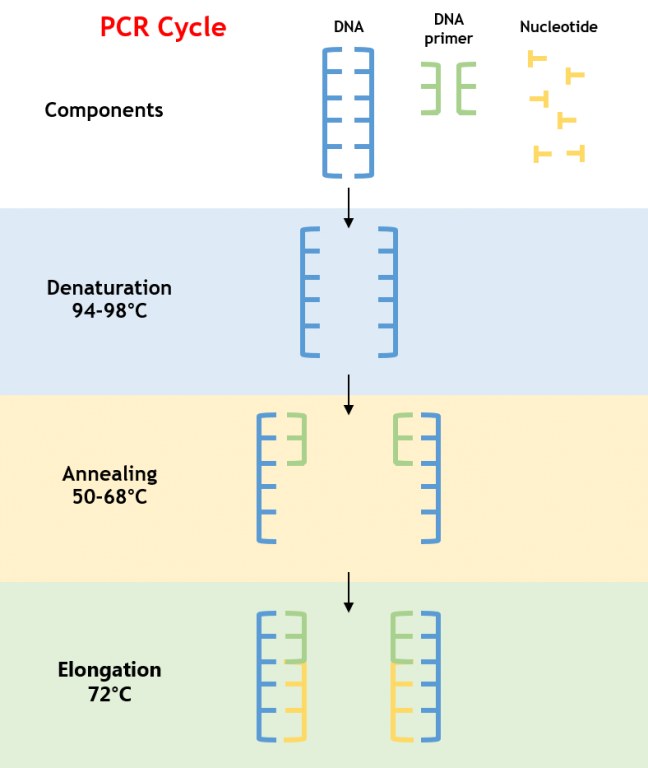During Which Step in the Pcr Cycle Are Nucleotides Used
During which step in the pcr cycle are nucleotides used. Adding on complementary nucleotides and reheating to 72 degrees Celsius for 60 seconds.

Pcr Process Steps Explained Cole Parmer France
PCR is very precise and can be used to amplify or copy a specific DNA target from a mixture of DNA molecules.

. The reaction can be divided into 4 steps. In this step the reaction mixture is heated temperature during the step is about 94C to 98C for 45 to 50 seconds. At the beginning of the PCR reaction the temperature is usually set up to 9598C depending on the polymerase used.
The extension step also referred to as the elongation step is the PCR step in which Taq polymerase adds nucleotides to the annealed primer. This step entails the extension of new strands of DNA starting with the primers. PCR Temperature Cycle.
This occurs at very high temperature of 94-96C hence why heat tolerate polymerases are used such as Taq and Pfu. Which enzymes will produce a DNA fragment that. It is the first step in Polymerase Chain Reaction PCR.
Annealing- the temperature is lowered to allow the primers to bind the DNA. These primers are used to flank the region of the DNA that we want to be copied. During which step in the PCR cycle are nucleotides used.
Primers will anneal to the DNA template during the Annealing step indeed which is after the Denaturation step. The polymerization of new DNA. These primers bind to the complementary strand of the DNA template.
In fact during this step the DNA template is heated to about The second step in a PCR cycle is carried at 55-65C and is called In few sentences describe what happens during this step. The temperature of this step depends on the melting temperature of the primer combination. After some preliminary steps the PCR cycle that we will use is the following.
These steps are as follows. A primer is a short sequence of nucleotides that provides the starting point for the DNA polymerase taq to attach to. Steps of PCR reaction.
During primer annealing the primers bind to the appropriate parts of the DNA strand. This process provides a new duplicate double-stranded DNA molecule formed from each of the single strands of the original sample molecule. After extension the reaction is heated back to 95 degrees Celsius to start another cycle of PCR.
Denaturation at 94-98C The first step of PCR reaction is known as denaturation. All of these steps. Priming the DNA by cooling the test tube to 50 degrees Celsius for 30 seconds.
Polymerase chain reaction or PCR is a laboratory technique used to make multiple copies of a segment of DNA. During which step in the PCR cycle are nucleotides used. This will allow the DNA template to unwind remove secondary structures and make it free to be bound by the primers.
How many DNA molecules would there be after four rounds of PCR if the initial reaction mixture contained two molecules. The third step extension occurs at 72 degrees Celsius. A PCR is a cyclic process and a single PCR cycle involves three main steps.
Annealing The binding of the forward and reverse primers to the complementary sequences on the template. C The third step in a PCR cycle is called the extension or elongation step. 9 rows During which step in the PCR cycle are nucleotides used.
During which step in the PCR cycle are nucleotides used. During which step in the PCR cycle are nucleotides used. The process of repeating the denaturation annealing.
550 C for 30 sec - Primer Annealing Step. The first of 3 PCR steps is a denaturation step. The number of strands of DNA after each cycle.
The three steps of PCR are. 720 C for 90 sec - Extension Step - New DNA molecules are made. Separation- the two strands of the DNA double helix are melted apart to create single strands.
During this step DNA strands that are complementary to the DNA template are formed. Furthermore the three main steps involved in a PCR are. During this step the DNA fragments are heated to a high temperature of about 94ᵒC to 95ᵒC.
During the denaturation step the hydrogen bonds that hold together the two strands of the double-stranded nucleic acids are broken and the strands unwind from each other. In this example the marker DNA includes fragments that have 23130 9416 6557 4361 2322 2027 and 564 base pairs. Eeeeee9918 is waiting for your help.
Flow chart of the three main steps of PCR with the PCR temperature cycle number of cycles and total program length. 940 C for 60 sec - DNA Denaturation Step. Denaturation Melting DNA duplex into two single strands by heating to 94-95 C.
This process releases single-stranded DNA to act as templates in the final PCR extension step. During which step in the PCR cycle do primers form bonds with a single-stranded template. At this temperature the double-stranded DNA in the mixture denatures into single strands.
During which step in the PCR cycle are nucleotides used. Unwinding the double helix by heating to 95 degrees Celsius for 30 seconds. PCR cycles can vary in temperatures and also in the length of time spent at any one temperature during a cycle.
Nucleotides are used to. Add your answer and earn points. It depends on the GC content of DNA.

What Are The Three Basic Steps Of Conventional Pcr Praxilabs

Polymerase Chain Reaction Pcr Steps Types Applications Microbe Online

Comments
Post a Comment